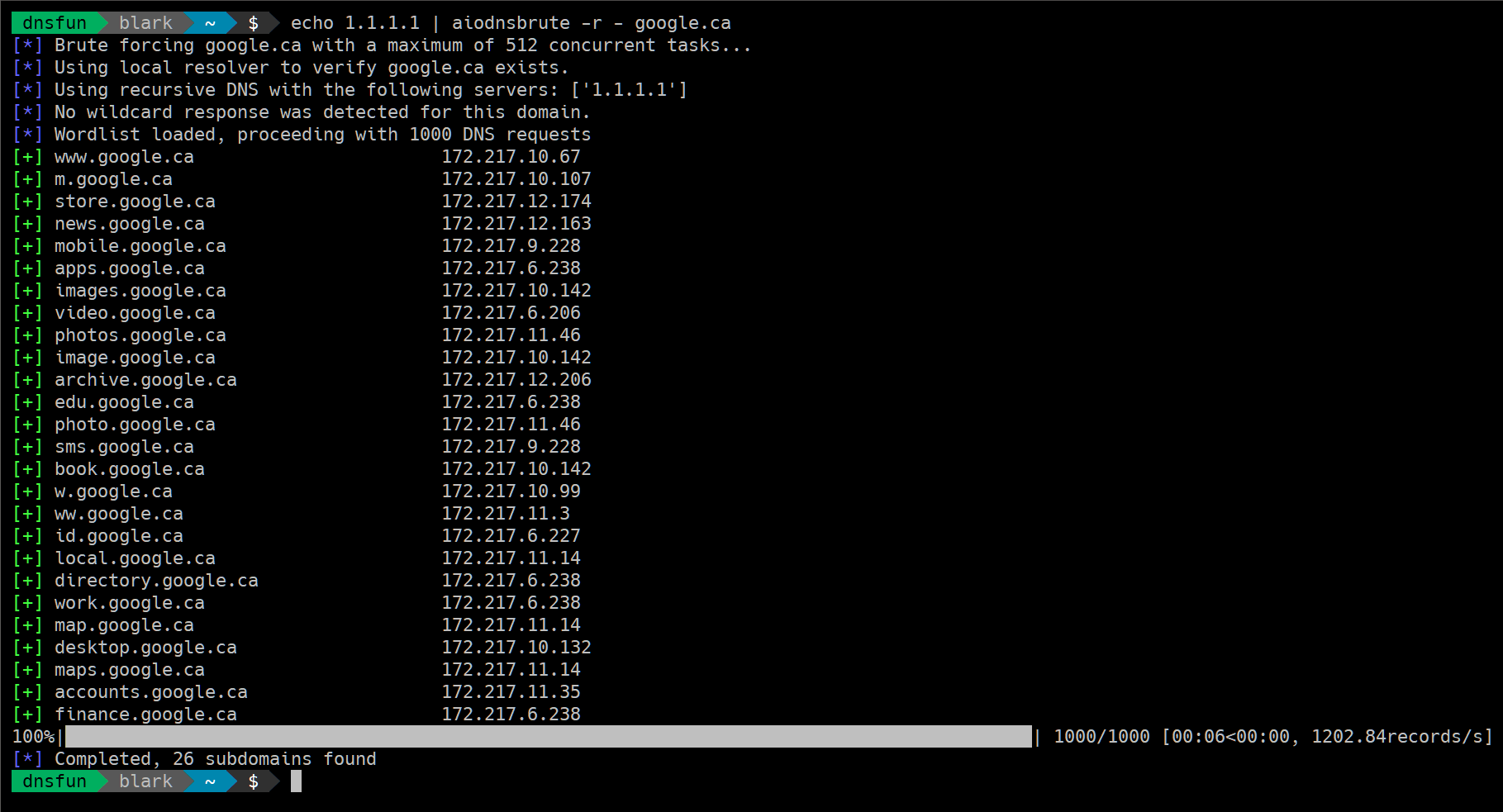This tool utilizes asyncio in Python 3.5+ to carry out asynchronous brute force attacks on domain names.
Speed
The performance is impressive. Based on benchmarks conducted on small VPS hosts, the system can handle around 100k DNS resolutions in 1.5-2 minutes. Additionally, using an Amazon M3 box, the system was able to process 1 million requests in just over 3 minutes. However, actual results may vary. It is recommended to avoid using Google’s resolvers if speed is your main concern.
Disclaimer
1. If you’re looking for speed, it’s likely that the DNS servers provided by your ISP and home router aren’t very good. You might want to consider using a VPS with fast resolvers instead, or setting up your own.
2. Please be advised that this tool has the potential to generate significant amounts of DNS traffic. Kindly note that I cannot be held liable if you inadvertently cause a Denial of Service (DoS) attack on someone’s DNS servers.
Installation
1
pip install aiodnsbrute
Note: It is strongly advised to utilize a virtualen
Alternate Install
1
git clone https://github.com/blark/aiodnsbrute.git
1
cd aiodnsbrute
1
python setup.py install .
Usage
1
2
3
4
5
6
7
8
9
10
11
12
13
14
15
16
17
18
19
20
21
22
23
24
25
26
27
aiodnsbrute --help
Usage: cli.py [OPTIONS] DOMAIN
aiodnsbrute is a command line tool for brute forcing domain names
utilizing Python's asyncio module.
credit: blark (@markbaseggio)
Options:
-w, --wordlist TEXT Wordlist to use for brute force.
-t, --max-tasks INTEGER Maximum number of tasks to run asynchronosly.
-r, --resolver-file FILENAME A text file containing a list of DNS resolvers
to use, one per line, comments start with #.
Default: use system resolvers
-v, --verbosity Increase output verbosity
-o, --output [csv|json|off] Output results to DOMAIN.csv/json (extension
automatically appended when not using -f).
-f, --outfile FILENAME O utput filename. Use '-f -' to send file
output to stdout overriding normal output.
--query / --gethostbyname DNS lookup type to use query (default) should
be faster, but won't return CNAME information.
--wildcard / --no-wildcard Wildcard detection, enabled by default
--verify / --no-verify Verify domain name is sane before beginning,
enabled by default
--version Show the version and exit.
--help Show this message and exit.
Usage
Perform a brute force operation with specific custom parameters:
1
aiodnsbrute -w wordlist.txt -vv -t 1024 domain.com
Execute a brute force operation, silence regular output, and exclusively transmit JSON data to the standard output.
1
aiodnbrute -f - -o json domain.com
If you require a more advanced pattern, you can employ customized resolvers and then direct the output through the powerful jq tool.
1
aiodnsbrute -r resolvers.txt -f - -o json google.com | jq '.[] | select(.ip[] | startswith("172."))'
By default, the detection of wildcards is enabled (it can be turned off using the flag “–no-wildcard”).
1
2
3
4
5
6
7
8
aiodnsbrute foo.com
[*] Brute forcing foo.com with a maximum of 512 concurrent tasks...
[*] Using recursive DNS with the following servers: ['50.116.53.5', '50.116.58.5', '50.116.61.5']
[!] Wildcard response detected, ignoring answers containing ['23.23.86.44']
[*] Wordlist loaded, proceeding with 1000 DNS requests
[+] www.foo.com 52.73.176.251, 52.4.225.20
100%|██████████████████████████████████████████████████████████████████████████████| 1000/1000 [00: 05<00:00, 140.18records/s]
The utilization of gethostbyname function can be advantageous in detecting CNAMEs, which is helpful in identifying potential subdomain takeover vulnerabilities.
1
aiodnsbrute --gethostbyname domain.com
To provide a list of resolvers from a file, omitting any blank lines and those starting with #, you can use the following command: “-r -“ allows you to read the list from stdin.
1
aiodnsbrute -r resolvers.txt domain.com
Note: To determine the number of allowed open files, you could run the command “ulimit -n”. Similarly, if you wish to increase this limit, you can utilize the same command by specifying a higher value, for instance, “ulimit -n <2048>”.
⚠ ONLY USE FOR EDUCATIONAL PURPOSES ⚠

